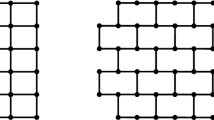Abstract
The semidefinite programming formulation of the Lovász theta number does not only give one of the best polynomial simultaneous bounds on the chromatic number χ(G) or the clique number ω(G) of a graph, but also leads to heuristics for graph coloring and extracting large cliques. This semidefinite programming formulation can be tightened toward either χ(G) or ω(G) by adding several types of cutting planes. We explore several such strengthenings, and show that some of them can be computed with the same effort as the theta number. We also investigate computational simplifications for graphs with rich automorphism groups.
Similar content being viewed by others
References
Benson, S., Ye, Y.: Approximating maximum stable set and minimum graph coloring problems with the positive semidefinite relaxation. In: Applications and Algorithms of Complementarity, pp. 1–18. Kluwer, Dordrecht (2000)
Benson S., Ye Y., Zhang X. (2000): Solving large-scale sparse semidefinite programs for combinatorial optimization. SIAM J. Optim. 10, 443–461
Bomze I.M., de Klerk E. (2002): Solving standard quadratic optimization problems via linear, semidefinite and copositive programming. J. Global Optim. 24, 163–185
Burer S., Monteiro R.D.C. (2003): A nonlinear programming algorithm for solving semidefinite programs via low-rank factorization. Math. Program. 95, 329–357
Burer S., Vandenbussche D. (2006): Solving lift-and-project relaxations of binary integer programs. SIAM J. Optim. 16, 726–750
Busygin, S., Pasechnik, D.V.: On \(\bar\chi(G)-\alpha(G)>0\) gap recognition and α(G)-upper bounds. Electronic Colloquium on Computational Complexity, Report No. 52 pp. 1–5 (2003)
Charikar, M.: On semidefinite programming relaxations for graph coloring and vertex cover. In: Proceedings of the 41th Annual ACM-SIAM Symposium on Discrete Algorithms, pp. 616–620 (2002)
Dukanovic, I.: Semidefinite programming applied to graph coloring problem. PhD Thesis, University of Klagenfurt, Austria (2006) (forthcoming)
Dukanovic, I., Rendl, F.: A semidefinite programming based heuristic for graph coloring. Discrete Appl. Math. (to appear)
Dukanovic, I., Rendl, F.: Copositive programming motivated bounds on the clique and the chromatic number of a graph. Preprint (2006)
Gatermann K., Parrilo P.A. (2004): Symmetry groups, semidefinite programs, and sums of squares. J. Pure Appl. Algebra 192, 95–128
Grötschel M., Lovász L., Schrijver A. (1988): Geometric Algorithms and Combinatorial Optimization. Springer, Berlin Heidelberg New York
Gruber G., Rendl F. (2003): Computational experience with stable set relaxations. SIAM J. Optim. 13, 1014–1028
Gvozdenović, N., Laurent, M.: Approximating the chromatic number of a graph by semidefinite programming. Working paper (2005)
Helmberg C., Rendl F. (2000): A spectral bundle method for semidefinite programming. SIAM J. Optim. 10, 673–696
Hertz A., Werra D.D. (1987): Using tabu search for graph coloring. Computing 39, 345–351
Karger D., Motwani R., Sudan M. (1998): Approximate graph coloring by semidefinite programming. J. Assoc. Comput. Mach. 45, 246–265
de Klerk, E., Pasechnik, D.V., Schrijver, A.: Reduction of symmetric semidefinite programs using the regular *-representation. Math. Program. (2005)(to appear)
de Klerk E., Pasechnik D.V., Warners J.P. (2004): On approximate graph colouring and max-k-cut algorithms based on the θ-function. J. Combinat. Optim. 8, 267–294
Knuth D.E. (1994): The sandwich theorem. Elect. J. Combinat. 1, 1–48
Laurent, M., Rendl, F.: Semidefinite programming and integer programming. In: R.W.e. K. Aardal G. Nemhauser (ed.) Handbook on Discrete Optimization, pp. 393–514. Elsevier, Amsterdam (2005)
Lovász L. (1979): On the Shannon capacity of a graph. IEEE Trans. Inf. Theory 25, 1–7
Lovász L., Schrijver A. (1991): Cones of matrices and set-functions and 0-1 optimization. SIAM J. Optim. 1, 166–190
Malick, J., Povh, J., Rendl, F., Wiegele, A.: A boundary point method to solve semidefinite programs. Working paper (2006)
Margot F. (2001): Pruning by isomorphism in branch-and-cut. Lect. Notes Comput. Sci. 2081, 304–317
McEliece J.R., Rodemich E., Rumsey H. (1978): The Lovász bound and some generalizations. J. Combinat. Syst. Sci. 3, 134–152
McKay B.D. (1981): Practical graph isomorphism. Congressus Numer. 30, 45–87
Meurdesoif P. (2005): Strengthening the Lovász \(\theta(\overline{G})\) bound for graph coloring. Math. Program. 102, 577–588
Murty K.G., Kabadi S.N. (1987): Some NP-complete problems in quadratic and nonlinear programming. Math. Program. 39, 117–129
Parrilo, P.A.: Structured semidefinite programs and semialgebraic geometry methods in robustness and optimization. PhD Thesis, California Institute of Technology (2000)
Parrilo, P.A., Sturmfels, B.: Minimizing polynomial functions. In: S. Basu, L.G.V. (eds.) Algorithmic and quantitative real algebraic geometry. DIMACS Series in Discrete Mathematics and Theoretical Computer Science, vol. 60, pp. 83–99. AMS New york (2003)
Schrijver A. (1979): A comparison of the Delsarte and Lovász bounds. IEEE Trans. Info. Theory IT-25, 425–429
Schrijver A. (2004): New code upper bounds from the Terwilliger algebra. IEEE Trans. Infor. Theory 51, 2859–2866
Szegedy, M.: A note on the theta number of Lovász and the generalized Delsarte bound. In: 35th Annual Symposium on Foundations of Computer Science, pp. 36–39 (1994)
Toh K., Kojima M. (2002): Solving some large scale semidefinite programs via the conjugate residual method. SIAM J. Optim. 12, 669–691
Vesel A., Žerovnik J. (2002): Improved lower bound on the Shannon capacity of C7. Inf. Process. Lett. 81 (5): 277–282
Author information
Authors and Affiliations
Corresponding author
Additional information
Partial support by the EU project Algorithmic Discrete Optimization (ADONET), MRTN-CT-2003-504438, is gratefully acknowledged.
Rights and permissions
About this article
Cite this article
Dukanovic, I., Rendl, F. Semidefinite programming relaxations for graph coloring and maximal clique problems. Math. Program. 109, 345–365 (2007). https://doi.org/10.1007/s10107-006-0026-z
Received:
Accepted:
Published:
Issue Date:
DOI: https://doi.org/10.1007/s10107-006-0026-z




